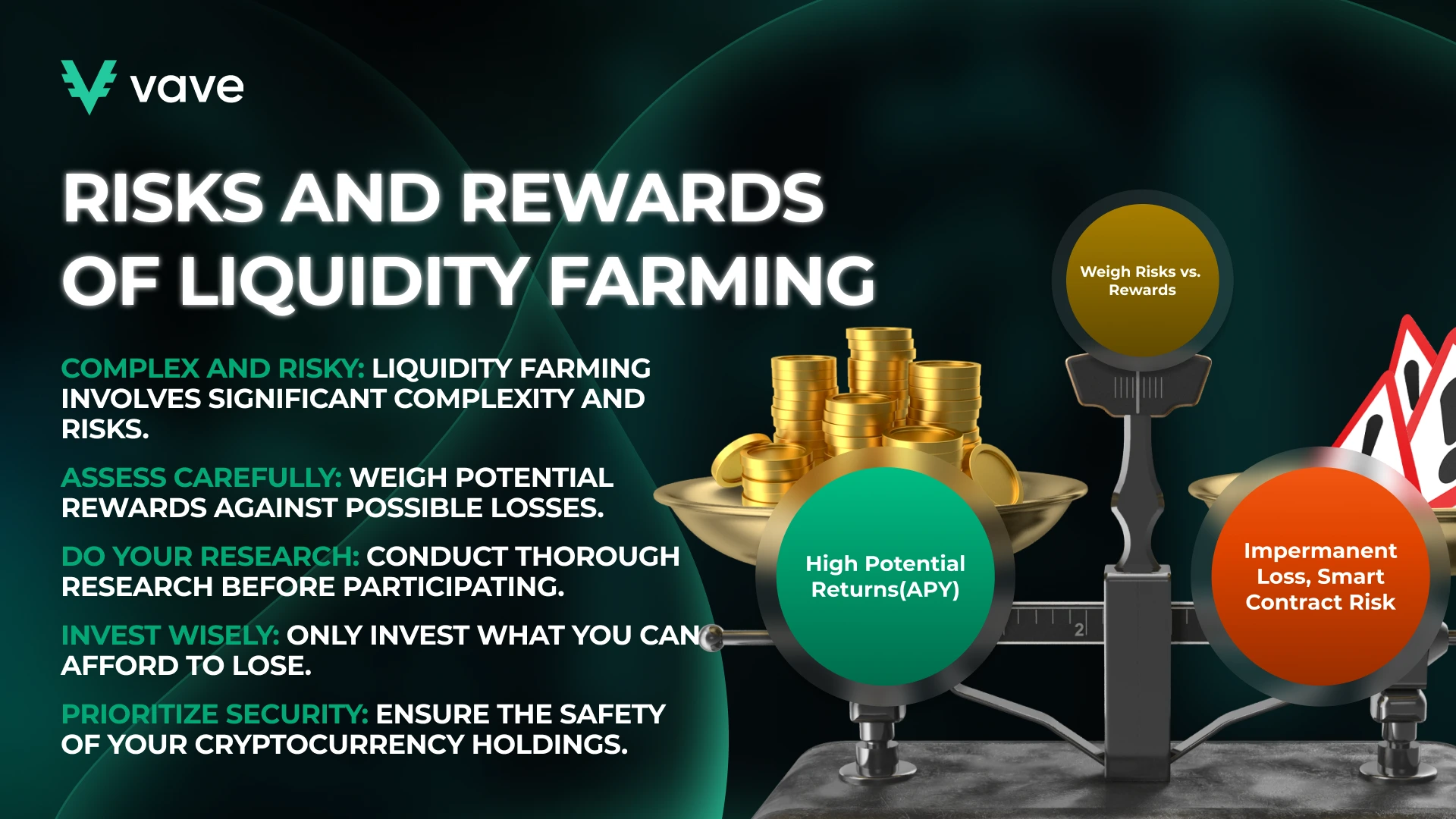Liquidity farming (also known as yield farming) is a valid route to earning passive income in the decentralized finance (DeFi) sphere. By providing liquidity to DeFi exchanges, users become eligible for certain rewards.
Yield farming also involves participants finding a liquidity pool using assets, which are used to fulfill trading or lending. These actions enable participants to receive a share of platform tokens or transaction fees. But how does DeFi yield farming work and what kind of rewards can you expect? In this guide we will explore all this and more.
What Is Liquidity Farming?
Liquidity farming is a key feature of decentralized finance (DeFi). This innovative investment method allows cryptocurrency owners to contribute their digital assets to liquidity pools, which are crucial for DEX (decentralized exchange) operations. These include trading, lending, and direct borrowing.
These pools are repositories of pooled assets that execute orders without the need for market makers. When participants add their assets, liquidity providers contribute to the main structural framework of the DEXs. This ensures enough levels of liquidity, improving the effectiveness of the trading activities facilitated on the platform.
As compensation for their capital, liquidity providers primarily receive passive income from transaction costs. These charges appear for each transaction in the pool and are shared in proportion to the participants’ contributions. This fee structure ensures liquidity in the system, aligning the interests of investors with the welfare of the platform.
Besides commissions, liquidity providers are often compensated in native tokens. These rewards are often optimized by various DeFi platforms via liquidity mining programs. Native tokens serve as incentives for participants to make further investments.
NOTE: Liquidity farming and DeFi staking are quite similar, as both mediums provide passive income from locked-in assets. You’ll find numerous articles with topics hovering around DeFi staking vs. liquidity farming. However, liquidity farming contributes liquidity to a platform for trading, whereas staking supports blockchain network security. Both provide passive income but have different mechanisms and risk profiles.
How Does Liquidity Farming Work?

So, how does liquidity farming work? Liquidity farming, albeit simple, has a rather creative mechanism. Cryptocurrency holders begin by putting their digital assets into a liquidity pool featuring different tokens bound by a smart contract.
Assets submitted into these pools are used for trading activities on the site. They can be used for margin trading, lending, and derivatives trading. As such, low or high APY (Annual Percentage Yield) liquidity pools are one of the most important elements in DeFi.
Liquidity provision involves entering a pool to earn back the initial investment plus returns. Compensation comes in the form of a transaction fee charged for the geo-tagged pooled activity. These fees are allocated based on each provider’s share in the pool as compensation.
On a side note, you might compare liquidity farming with crypto lending. While both are DeFi income strategies, liquidity farming is far more volatile than crypto lending. Yield farming has high risks and rewards while crypto lending is stable and delivers decent payouts.
Exploring Different Blockchain Ecosystems
The DeFi ecosystem isn’t confined to a single blockchain network. Although Ethereum currently offers the majority of DeFi products and services due to its foundational role in the ecosystem, several other chains, like Binance Smart Chain (BSC) and Solana, are also trending within this multifaceted industry.
These platforms are particular in certain requirements such as scalability, interoperability, and reduced transaction fees. Every blockchain system creates its tools, characteristics and user base. Therefore, liquidity farmers have multiple opportunities to make profits.
The Best Platforms For Yield Farming
Are you looking for yield farming platforms where you can find high-APY liquidity pools and make profits? Here are some of the best platforms to use for DeFi yield farming and associated activities:
Uniswap
Uniswap is gaining traction among yield farmers due to its ease of use and high liquidity. This platform is an automated market maker (AMM) system that eliminates the need for order books. Uniswap simplicity makes it one of the best DeFi platforms for beginners.
SushiSwap
SushiSwap started as a copy of Uniswap. However, this yield farming platform went on to add revolutionary features (such as their own governance token called SUSHI, and several DeFi (Decentralized Finance) products) which are more in line with community decisions.
MakerDAO
MakerDAO functions as an issuer and lender of stablecoins. However, it also participates in the farming of liquidity. How? By providing users with an opportunity to get DAI (a decentralized stablecoin) in return for their cryptocurrencies with which they can engage in yield farming. With these components, MakerDAO ranks among the best DeFi platforms for yield farming.
TIP: It’s important that you research DeFi platforms before investing in yield farming ventures. That way, you’ll find alternatives that suit your investment needs.
How Is Liquidity Farming Profitable for Users?
Liquidity farming’s profitability depends solely on two sources. The first is transaction fees. Fees are generated through trades, and they are distributed to liquidity providers based on their share in the pool. Note that these amounts are proportionate to their share in the pool.
The second element of profitability that has emerged with liquidity mining is that providers are rewarded with new tokens. Since the value of these tokens may increase over time, investors are eligible for high profits.
However, keep in mind that profitability varies depending on market conditions and token value fluctuations
Risks and Considerations Before Diving In

Before diving into crypto yield farming, it’s important to gauge the risks involved in associated activities.
The Ever-Present Threat of Impermanent Loss
Impermanent loss in crypto occurs when the price of tokens in the pool differs from the price at the time of contribution. This may lead to a situation where the value of tokens that you deposited into the liquidity pool fluctuates compared to when you just hold them. The term “impermanent” comes into play as you’ll most likely experience a loss when you withdraw after a price change.
Smart Contract Vulnerabilities and Platform Risks
Smart contracts are key to yield farming. These contracts are coded instructions that are used to facilitate the movement of funds within a liquidity pool. However, if the contract is buggy or has been breached by cybercriminals, funds could be stolen or permanently locked.
That said, yield platforms aren’t free from similar vulnerabilities. Some variations could have a design flaw that could result in unexpected shutdowns and breaches. These unpleasant scenarios could lead to financial losses.
Managing Volatility in the Cryptocurrency Market
The cryptocurrency market is known for its volatility, and this unpredictability is one of the many liquidity farming risks to expect. This means the value of native tokens issued as rewards to yield farmers could fluctuate at any time.
Conclusion
Liquidity farming is a great way for crypto holders to generate passive income from DeFi engagements. However, you must know the basic liquidity farming strategies, the procedures of your preferred platform, and the dangers tied to yield farming. By constantly improving your knowledge and learning how to manage risks in liquidity farming, you can earn substantial profits.
FAQ
What is liquidity farming in crypto, and is it legit?
What kind of rates can I expect from liquidity farming?
How can I profit from liquidity farming, and where can I find a guide?
Glossary
- Smart Contracts: A self-regulating blockchain agreement responsible for the fund distribution without intermediates.
- Decentralized Exchange: A P2P (peer-to-peer) marketplace where people can trade cryptocurrencies without needing an intermediary.
- Stablecoin: A cryptocurrency with a relatively stable price. This value is usually pegged to another commodity or determined when an algorithm throttles its supply.


















